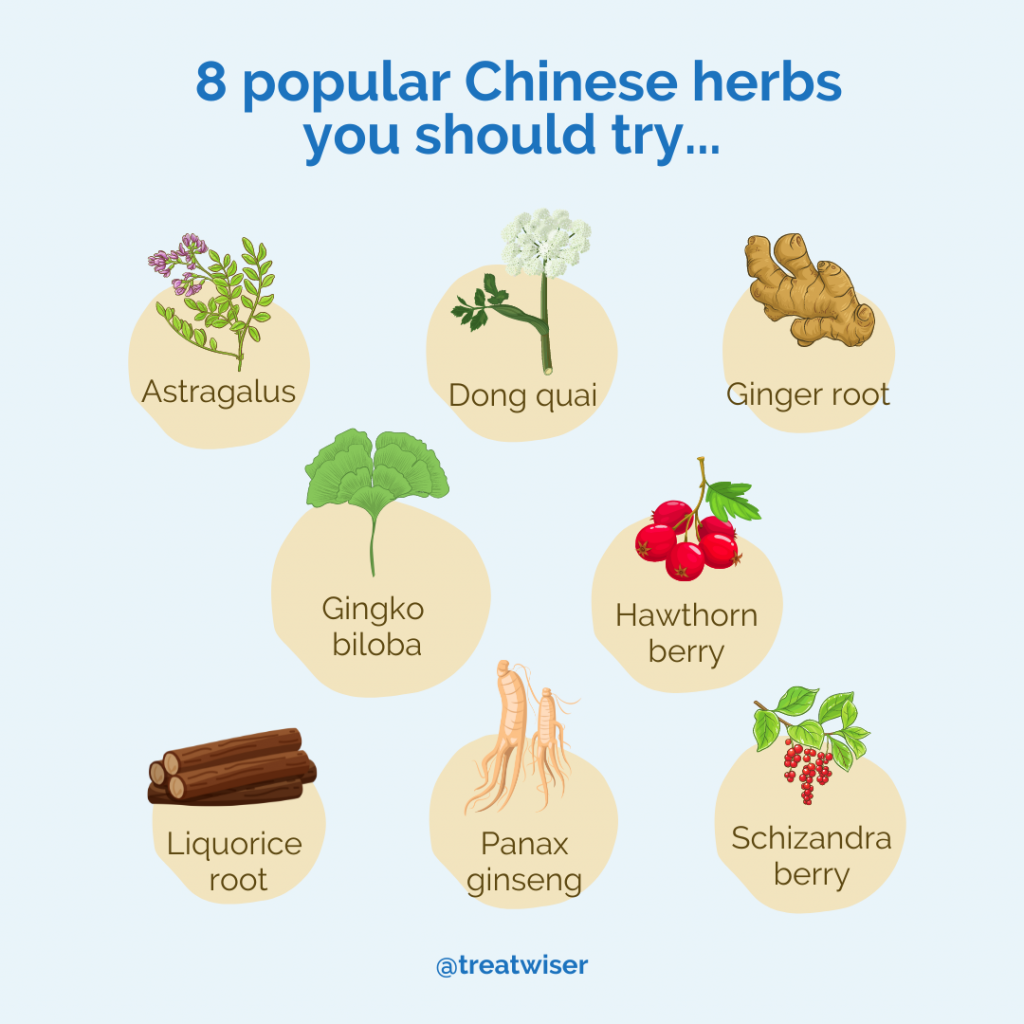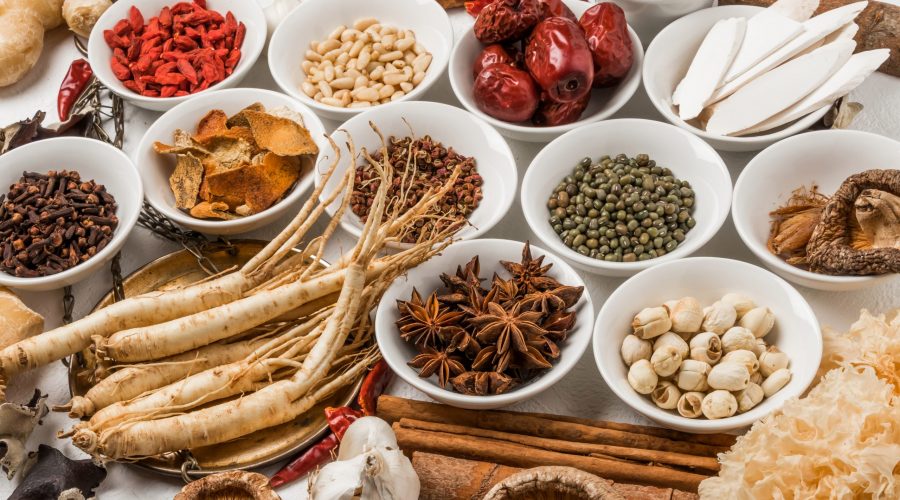Herbal medicine is one of the foundations of Traditional Chinese medicine (TCM), an ancient, all-natural healthcare system that addresses the root cause of mental and physical symptoms. There are literally hundreds of herbs in Chinese medicine. Herbs balance yin and yang energy, remove blockages in the Qi energy system (your life force) and nourish your organs.
Today we’ll look at the top 8 herbs gaining popularity in the west.

1. Astragalus
Astragalus – also known as Huang qi – is a Chinese medicinal herb with anti-inflammatory and anti-allergy properties.
Astragalus is rich in active plant compounds and is used to enhance energy levels after (not during) an acute illness. It supports your Wei qi – your protective/defensive qi – and improves your ability to handle stress.
How to take: Astragalus is available as a loose herb, capsule, powder, or tincture.
TCM practitioners often recommend adding a tablespoon of dried astragalus to a pot of boiling water to make a herbal infusion. You can drink this 1-3 times daily.
2. Dong quai
Dong quai is a Chinese herbal remedy made from the root of the Angelica sinensis plant (the same family as carrots and celery).
Interestingly, this popular Asian herb is known as “female ginseng” for its ability to support women’s health. It is ideal for treating premenstrual syndrome (PMS), low oestrogen, and hot flashes.1
How to take: Dong quai pills, tablets, and tinctures are the most popular. It’s also typically found in conjunction with other herbs in TCM concoctions. If you take a tincture, try 15 drops 1-3 times daily.
3. Ginger root
Ginger – from the Zingiber officinale rhizome – is a versatile herb (technically, it’s a root) used in Chinese medicine and cooking. It’s packed with bioactive compounds called gingerols, which researchers believe give it anti-inflammatory and analgesic properties.
Ginger has spicy, warming properties that support immunity, circulation, metabolism, and digestion. It’s also a common remedy for nausea, stomach discomfort, and morning sickness.
Like astragalus, ginger root strengthens Wei qi. It’s considered one of the best Chinese health foods.
How to take: Steep a 1-inch piece of fresh ginger in a pot of hot water for 10 minutes. Add a squeeze of lemon and a teaspoon of honey to make a delicious ginger tea.
If taking a capsule, studies typically use 1–3 grams of ginger root extract daily.
4. Ginkgo biloba
Ginkgo biloba extract is a herbal remedy made from the leaves of the ginkgo biloba tree. Archaeologists consider the ginkgo biloba tree a “living fossil” as it has existed for over 200 million years.
Ginkgo is a popular Asian herb and staple of TCM. Research suggests ginkgo biloba boosts nitric oxide (NO) – a gas that dilates your blood vessels and increases circulation to the brain and other organs.2 This is vital for brain health, vision, sexual performance, and heart health.
How to take: Evidence shows that 120–240 mg of standardised ginkgo biloba leaf extract is most effective.
5. Hawthorn berry
Hawthorn berry extract is a Chinese herbal remedy sourced from the tiny, edible berries of the hawthorn bush.
The berries are a great source of prebiotic fibre and polyphenols, crucial for optimal digestive function. They support digestive health and reduce heartburn and bloating. Research also shows hawthorn berry extract reduces blood pressure.3
How to take: If you’re using hawthorn berry extract to reduce blood pressure, research shows 600 mg (in capsule form) may be effective.
6. Liquorice root
Liquorice root is a sweet, fragrant herb that enhances yang (heat) energy in the body. Herbalists swear by liquorice root to raise low blood pressure, loosen phlegm in the chest, and bolster the immune system.
It’s also a favourite for easing digestive discomfort. Studies show liquorice extract may be more effective than antacid medication in some cases!4
How to take: Liquorice root extract is available in capsules, tea, powder, tinctures, and cough syrup.
To make tasty liquorice tea, steep 1-4 grams of loose liquorice root in a teapot for 10 minutes with a dash of raw honey. Drink a cup 1-3 times per day. It’s great for sore throats.
7. Panax ginseng
Panax ginseng – or Korean ginseng – is made from the steamed and dried root of the mature “Asian ginseng plant. It’s been given the name “the king of herbs” and is one of the most popular herbs in the west.
Ginseng may help people with low Qi and symptoms of yang deficiency like coldness, poor circulation, and fatigue. It’s believed to enhance energy levels and libido, improve stress resilience, increase cognitive function, and strengthen immune health.
How to take: Studies typically use 200-400 mg of standardised Panax ginseng extract. However, higher doses of up to 3 000 mg may help libido and sexual dysfunction.
8. Schizandra berry
Schizandra berry – also known as wu wei zi – is the fruit of the Schisandra chinensis plant, a climbing vine native to northern China.
This medicinal berry has been used for thousands of years, and ancient tribes took dried schizandra berries on cold excursions to keep them going. In TCM, schizandra is a kidney, liver, and lung tonic.
How to take: Schizandra berry is available as capsules, tinctures, tea, and powder. Supplements are probably the most convenient, but traditionally, it’s consumed in a herbal tea or tonic.
Make a tea by brewing 3 grams of freeze-dried Schisandra in hot water for 30 minutes. Add a dash of cinnamon and slice of ginger and drink 1-3 cups daily – warm or iced.
If you have a tincture, take 20-30 drops daily in water or juice.
Wrapping up
This list is ideal for beginners interested in exploring Chinese herbal medicine and those wanting to live a more holistic life.
That said, we encourage you to consult a practitioner trained in Chinese medical herbs – a doctor of TCM or a medical herbalist. They can prescribe the right blend of Chinese herbs for optimal well-being.
Resources
- Kupfersztain et al. (2003). The immediate effect of natural plant extract, Angelica sinensis and Matricaria chamomilla (Climex) for the treatment of hot flushes during menopause. Clin Exp Obstet Gynecol.
- Koltermann et al. (2007). Ginkgo biloba extract EGb 761 increases endothelial nitric oxide production in vitro and in vivo. Cell Mol Life Sci.
- Walker et al. (2002). Promising hypotensive effect of hawthorn extract: a randomized double-blind pilot study of mild, essential hypertension. Phytother Res.
- Setright. (2017). Prevention of symptoms of gastric irritation (GERD) using two herbal formulas. Journal of the Australian Traditional-Medicine Society.
DISCLAIMER: The Site cannot and does not contain medical / health advice. The medical / health information is provided for general informational and educational purposes only and is not a substitute for professional advice. Accordingly, before seeking any form of medical advice, diagnoses or treatment based upon such information, we encourage you to consult with your GP or other qualified health practitioner. You must never disregard professional medical advice or delay in seeking it because of something mentioned on this Site. The use or reliance of any information contained on the Site is solely at your own risk.





